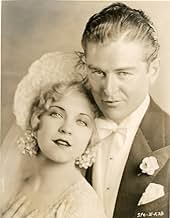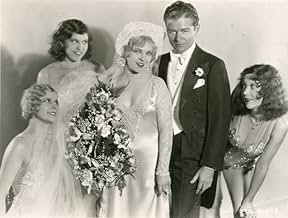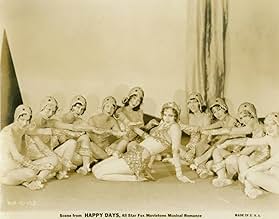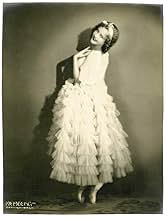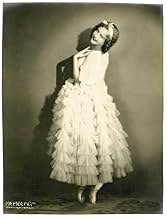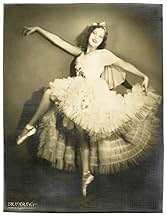अपनी भाषा में प्लॉट जोड़ेंIn Fox's contribution to the all-star revue cycle of early talkies, showboat singer Margie, hearing that the show is in arrears, goes to New York to gather all of the former stars to stage a... सभी पढ़ेंIn Fox's contribution to the all-star revue cycle of early talkies, showboat singer Margie, hearing that the show is in arrears, goes to New York to gather all of the former stars to stage a minstrel show as a benefit.In Fox's contribution to the all-star revue cycle of early talkies, showboat singer Margie, hearing that the show is in arrears, goes to New York to gather all of the former stars to stage a minstrel show as a benefit.
- पुरस्कार
- कुल 2 जीत
फ़ीचर्ड समीक्षाएं
Fox's all-star musical revue is short on star power, but there are a few terrific numbers here.
The plot revolves around a bunch of Broadway stars who get coerced into trying to save a show boat by doing a benefit show. Of course the sets make little sense as they could hardly fit on a show boat stage, but the minstrel theme (similar to the opening of MGM's all-star revue, THE Hollywood REVUE OF 1929) is used to introduce the various acts.
Among the better known stars here are Fox's #1 romantic team of Janet Gaynor and Charles Farrell, who sing "We'll Build a Little World of Our Own." Gaynor would remain a big star throughout the 30s, but Farrell struggled with his voice and had only a so-so career in talkies.
Victor McLaglen and Edmund Lowe sing a novelty song called "Vic and Eddie." Ann Pennington does a terrific dance to "Snake Hips," which is sung by Sharon Lynn. The dynamic Marjorie White and Richard Keene sing "I'm on a Diet of Love." Frank Richardson sings "Mona." Whispering Jack Smith sings the title song of "Happy Days." Other stars who appear include George Jessel (but he doesn't sing), Walter Catlett, William Collier, El Brendel, Frank Albertson, Stu Erwin, Tom Patricola, Nick Stuart, Rex Bell, Warner Baxter, Will Rogers, Dixie Lee, and boxer Jim Corbett.
Lots of energy here and Marjorie White (in her film debut) probably comes off best. She died in a car wreck in 1935. At only 4' 10" White was a dynamo of musical and comedy talent and had good supporting roles on Fox's JUST IMAGINE and SUNNYSIDE UP.
Of all the studio all-star revues, which often introduced many silent stars to talkies, HAPPY DAYS holds its own with THE Hollywood REVUE OF 1929 (MGM) and PARAMOUNT ON PARADE (Paramount) despite the lack of musical star power.
The plot revolves around a bunch of Broadway stars who get coerced into trying to save a show boat by doing a benefit show. Of course the sets make little sense as they could hardly fit on a show boat stage, but the minstrel theme (similar to the opening of MGM's all-star revue, THE Hollywood REVUE OF 1929) is used to introduce the various acts.
Among the better known stars here are Fox's #1 romantic team of Janet Gaynor and Charles Farrell, who sing "We'll Build a Little World of Our Own." Gaynor would remain a big star throughout the 30s, but Farrell struggled with his voice and had only a so-so career in talkies.
Victor McLaglen and Edmund Lowe sing a novelty song called "Vic and Eddie." Ann Pennington does a terrific dance to "Snake Hips," which is sung by Sharon Lynn. The dynamic Marjorie White and Richard Keene sing "I'm on a Diet of Love." Frank Richardson sings "Mona." Whispering Jack Smith sings the title song of "Happy Days." Other stars who appear include George Jessel (but he doesn't sing), Walter Catlett, William Collier, El Brendel, Frank Albertson, Stu Erwin, Tom Patricola, Nick Stuart, Rex Bell, Warner Baxter, Will Rogers, Dixie Lee, and boxer Jim Corbett.
Lots of energy here and Marjorie White (in her film debut) probably comes off best. She died in a car wreck in 1935. At only 4' 10" White was a dynamo of musical and comedy talent and had good supporting roles on Fox's JUST IMAGINE and SUNNYSIDE UP.
Of all the studio all-star revues, which often introduced many silent stars to talkies, HAPPY DAYS holds its own with THE Hollywood REVUE OF 1929 (MGM) and PARAMOUNT ON PARADE (Paramount) despite the lack of musical star power.
Fanatics will have to see this. People who just like early show business more or less will find much to enjoy with their finger hovering over the fast forward button.
The black face minstrelsy is probably 100% authentic given how many people involved with it in the 19th century were probably associated with this production. The ad-libbing by the Broadway crowd when the plot is being laid out is kind of dull, but may be an authentic replica of how those guys talked. George Jessel is making it up as he goes along and is not at his wittiest. But you get to see how the guys who seemed to be having all the fun dressed, walked, spoke, emoted, and loved each other.
The familiar now obsolete acts are here: burlesque of "high-class" dancers, heavy-accented "Yiddish" monologist, meek man with much taller over bearing wife, and so on. Come to think of it, this stuff never goes away entirely.
Correction to an earlier reviewer: the sets do make sense because if you listen to the set-up the show is in a theater, not on the show boat (remember, Jessel asks the theater owner if his theater is "dark", meaning is it unoccupied so this fund raiser can be presented in it).
It thankfully ends with the entire company taking a bow, and you silently applaud them up in Show Business Heaven.
The black face minstrelsy is probably 100% authentic given how many people involved with it in the 19th century were probably associated with this production. The ad-libbing by the Broadway crowd when the plot is being laid out is kind of dull, but may be an authentic replica of how those guys talked. George Jessel is making it up as he goes along and is not at his wittiest. But you get to see how the guys who seemed to be having all the fun dressed, walked, spoke, emoted, and loved each other.
The familiar now obsolete acts are here: burlesque of "high-class" dancers, heavy-accented "Yiddish" monologist, meek man with much taller over bearing wife, and so on. Come to think of it, this stuff never goes away entirely.
Correction to an earlier reviewer: the sets do make sense because if you listen to the set-up the show is in a theater, not on the show boat (remember, Jessel asks the theater owner if his theater is "dark", meaning is it unoccupied so this fund raiser can be presented in it).
It thankfully ends with the entire company taking a bow, and you silently applaud them up in Show Business Heaven.
I'm a big Marjorie White fan,but as a young actress, on the stage since childhood, and already a big hit in Sunny Side Up, why she agreed to take the part in this one, along with Charles Farrell and Janet Gaynor, I'll never know. On the whole, I find the entire film patently old-fashioned (even for its own time), ridiculously unfunny, except for George Jessel and Will Rogers, and I find it offensive to a great degree, the scene where the guy picks up Marjorie and physically throws her across the room, and the enormous chorus scene of blackface actors just horribly silly. And add El Brendel, the un-funniest comic of his time, and what we end with is a really forgettable piece, insulting, and not entertaining at all!
This film, which was just another musical in that crowded time of 1929-30, is truly dreadful to experience today. ANY of the musicals done by the other studios during this time would have been better. Charles Farrell and Janet Gaynor do a horrible number guaranteed to rot your teeth from all the sugar. Why Fox insisted on putting Frank Richardson in a musical is anybody's guess. A hideous shrieking screeching singer who could give a deaf person a headache. A few of the chorus numbers are okay, but pale next to the work in films like King of Jazz or Show of Shows. This was originally filmed in the early wide-screen process "Grandeur", but now is seen in an old dupe like the vastly superior Just Imagine from the same studio. I like Charles Farrell as Gale Storm's father in My Little Margie, and Janet Gaynor in the terrific A Star Is Born from 1937, but together, they may have been part of the reason for the big backlash against musicals in 1930. They are.......Icky!
Lavish story-revue from 1929, originally filmed in a widescreen process called Grandeur, puts most of Fox's roster in a minstrel show format; there's a plot surrounding it, but it's forgotten after the first half hour or so. You have to endure some badly dated acts, including the insufferable El Brendel and the sappy Janet Gaynor (she doesn't sing, she coos) and Charles Farrell (body of Adonis, voice of a fifth grader), but along the way you do get some good stuff, and an entertaining look at what was considered top-notch diversion around the time the stock market was crashing. Marjorie White does some hot scat singing and steps lightly; Ann Pennington and Dixie Lee dance up a storm; Victor McGlaglen and Edmund Lowe do a buddy number (McLaglen can actually sing, Lowe can't); the boxing champ James J. Corbett is a personable interlocutor; Will Rogers, Warner Baxter, and George Jessel do cameos; and poor old Charles Evans' show boat gets saved. The chorus girls are beefy and klutzy (Betty Grable's in there somewhere), the production design's clever, and there's an odd lighting effect that turns actors from blackface to white with the flick of a light switch. Heaven knows you couldn't get away with this stuff today, but the songs are catchy, there's some fine dancing, and among the large roster of early talkie musicals, this one's fairly diverting.
क्या आपको पता है
- ट्रिवियाThe second film released in 70mm widescreen (The Big Trail (1930) was the first).
- इसके अलावा अन्य वर्जनFilmed and released in two versions: standard (35 mm) and widescreen in the Grandeur process (70 mm). For its premiere showing, the widescreen version played at the Roxy Theatre in New York City, and was the first film ever shown entirely in widescreen. No print of the widescreen version is known to exist.
- कनेक्शनFeatured in Biography: Betty Grable: Behind the Pin-up (1995)
- साउंडट्रैकWe'll Build a Little World of Our Own
(uncredited)
Music by James F. Hanley
Lyrics by James Brockman
Copyright 1930 by Red Star Music Co. Inc
Performed by Janet Gaynor and Charles Farrell
टॉप पसंद
रेटिंग देने के लिए साइन-इन करें और वैयक्तिकृत सुझावों के लिए वॉचलिस्ट करें
विवरण
- चलने की अवधि
- 1 घं 20 मि(80 min)
इस पेज में योगदान दें
किसी बदलाव का सुझाव दें या अनुपलब्ध कॉन्टेंट जोड़ें

